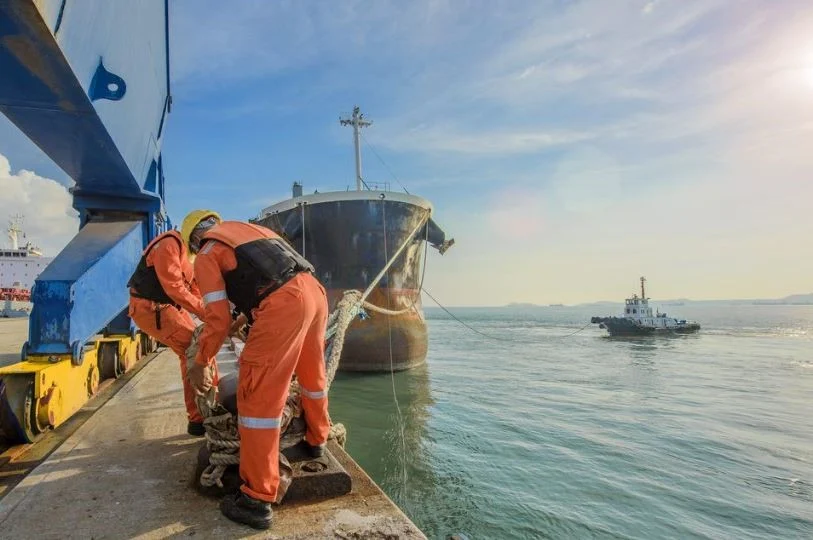When a ship reaches port, its engines may stop, but the work doesn’t. Mooring—the act of securing a ship to a dock or buoy—is one of the most delicate operations in seamanship. What looks simple from the shore is, in truth, a complex process requiring timing, spatial awareness, and teamwork across the deck and bridge.
What Mooring Involves
Mooring is the process of safely fastening a vessel to a fixed point—usually a jetty, quay, dolphin, or buoy—to keep it steady during cargo operations or laytime. This is done using mooring lines, which can include head lines, stern lines, breast lines, and spring lines. Each line plays a unique role in resisting forward, aft, or sideways motion.
Mooring configurations vary based on the ship’s length, port setup, and environmental conditions. A common arrangement is the 4+2 setup—four lines forward (typically 2 headlines and 2 springs) and two lines aft (a stern line and a spring). On larger vessels or in high-wind areas, setups like 6+3 or even 5+4 may be used to provide additional holding power and directional control.
Types of Mooring Setups
Conventional Berth Mooring – With multiple lines fastened to bollards. Most common in merchant shipping.
Mediterranean Mooring – Stern-to-berthing style, usually with anchors dropped ahead.
SPM (Single Point Mooring) – For tankers at sea, where the ship is tied to a central buoy and free to weathervane.
Dolphin Mooring – Where the ship is moored to distant fixed piles when there’s no full-length jetty.
Handling the Pivot Point
The pivot point of a vessel is a subtle but crucial element in ship handling. It shifts depending on whether the vessel is moving ahead, astern, or stationary:
Moving ahead: the pivot point is typically one-third from the bow.
Astern movement: it shifts closer to the stern.
Stationary or low speed: it moves nearer to midships.
This shifting point determines how the vessel swings during lateral moves, especially when using bow thrusters or tugs. Misjudging it can result in poor alignment or even hull contact. Officers who understand the dynamic pivot point avoid overuse of rudder or unnecessary thruster adjustments.
What Experience Teaches (That Manuals Don’t)
Lead angles matter more than line count. Six lines poorly led can be less effective than four with proper angles and lengths.
Winch lag is real. If you give a heaving command, there’s always a delay before the brake releases and the drum turns. Anticipate it—especially in changing wind conditions.
Bitts and bollards aren’t always where you expect them. Memorizing the layout of your home port won’t help much when visiting a smaller or non-standard terminal.
Mooring decks are noisy liars. You may not hear line tension changes by ear—visual feedback from rope stretch and bollard movement often gives better cues.
A tight line isn’t always a secure one. Over-tightening spring lines without compensating slack on head or stern lines can cause the ship to walk off the berth slowly with tide shifts.
Risks That Come With It
Snapback Zones – The most dangerous areas on deck. If a line parts under strain, it recoils at fatal speed. The safest place is never directly in the lead of a tensioned line.
Uneven Load Distribution – Can shear a bollard or overload one winch while others go slack.
Rough Weather Movement – Even moored ships move. Improperly aligned lines can grind against fairleads or chafe through during bad weather.
Tug Talk and Fine Control
During mooring, tugs aren’t just pushing or pulling—they’re holding position, adjusting angles, and responding to micro-movements from the bridge. A good officer knows when to ask for a steady hold instead of constant force. The difference lies in a gentle rotation versus an uncontrolled drift.
Wrapping Up the Lines, Holding the Position
Mooring is one of those operations that tests everything at once—bridge-to-deck communication, equipment reliability, weather reading, and spatial judgment. You don’t get a second chance to approach a berth cleanly or tension a line safely once it’s fast.
The best mariners don’t just follow mooring plans—they read the ship’s mood, watch the tide, and act two steps ahead.


